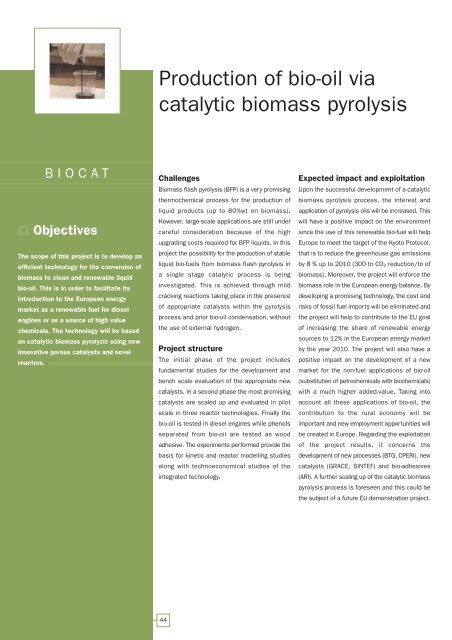European Bio-Energy Projects
European Bio-Energy Projects
European Bio-Energy Projects
You also want an ePaper? Increase the reach of your titles
YUMPU automatically turns print PDFs into web optimized ePapers that Google loves.
BIOCAT<br />
Objectives<br />
The scope of this project is to develop an<br />
efficient technology for the conversion of<br />
biomass to clean and renewable liquid<br />
bio-oil. This is in order to facilitate its<br />
introduction to the <strong>European</strong> energy<br />
market as a renewable fuel for diesel<br />
engines or as a source of high value<br />
chemicals. The technology will be based<br />
on catalytic biomass pyrolysis using new<br />
innovative porous catalysts and novel<br />
reactors.<br />
Production of bio-oil via<br />
catalytic biomass pyrolysis<br />
Challenges<br />
<strong>Bio</strong>mass flash pyrolysis (BFP) is a very promising<br />
thermochemical process for the production of<br />
liquid products (up to 80%wt on biomass).<br />
However, large-scale applications are still under<br />
careful consideration because of the high<br />
upgrading costs required for BFP liquids. In this<br />
project the possibility for the production of stable<br />
liquid bio-fuels from biomass flash pyrolysis in<br />
a single stage catalytic process is being<br />
investigated. This is achieved through mild<br />
cracking reactions taking place in the presence<br />
of appropriate catalysts within the pyrolysis<br />
process and prior bio-oil condensation, without<br />
the use of external hydrogen.<br />
Project structure<br />
The initial phase of the project includes<br />
fundamental studies for the development and<br />
bench scale evaluation of the appropriate new<br />
catalysts. In a second phase the most promising<br />
catalysts are scaled up and evaluated in pilot<br />
scale in three reactor technologies. Finally the<br />
bio-oil is tested in diesel engines while phenols<br />
separated from bio-oil are tested as wood<br />
adhesive. The experiments performed provide the<br />
basis for kinetic and reactor modelling studies<br />
along with technoeconomical studies of the<br />
integrated technology.<br />
44<br />
Expected impact and exploitation<br />
Upon the successful development of a catalytic<br />
biomass pyrolysis process, the interest and<br />
application of pyrolysis oils will be increased. This<br />
will have a positive impact on the environment<br />
since the use of this renewable bio-fuel will help<br />
Europe to meet the target of the Kyoto Protocol,<br />
that is to reduce the greenhouse gas emissions<br />
by 8 % up to 2010 (300 tn CO2 reduction/tn of<br />
biomass). Moreover, the project will enforce the<br />
biomass role in the <strong>European</strong> energy balance. By<br />
developing a promising technology, the cost and<br />
risks of fossil fuel imports will be eliminated and<br />
the project will help to contribute to the EU goal<br />
of increasing the share of renewable energy<br />
sources to 12% in the <strong>European</strong> energy market<br />
by the year 2010. The project will also have a<br />
positive impact on the development of a new<br />
market for the non-fuel applications of bio-oil<br />
(substitution of petrochemicals with biochemicals)<br />
with a much higher added-value. Taking into<br />
account all these applications of bio-oil, the<br />
contribution to the rural economy will be<br />
important and new employment opportunities will<br />
be created in Europe. Regarding the exploitation<br />
of the project results, it concerns the<br />
development of new processes (BTG, CPERI), new<br />
catalysts (GRACE, SINTEF) and bio-adhesives<br />
(ARI). A further scaling up of the catalytic biomass<br />
pyrolysis process is foreseen and this could be<br />
the subject of a future EU demonstration project.

















